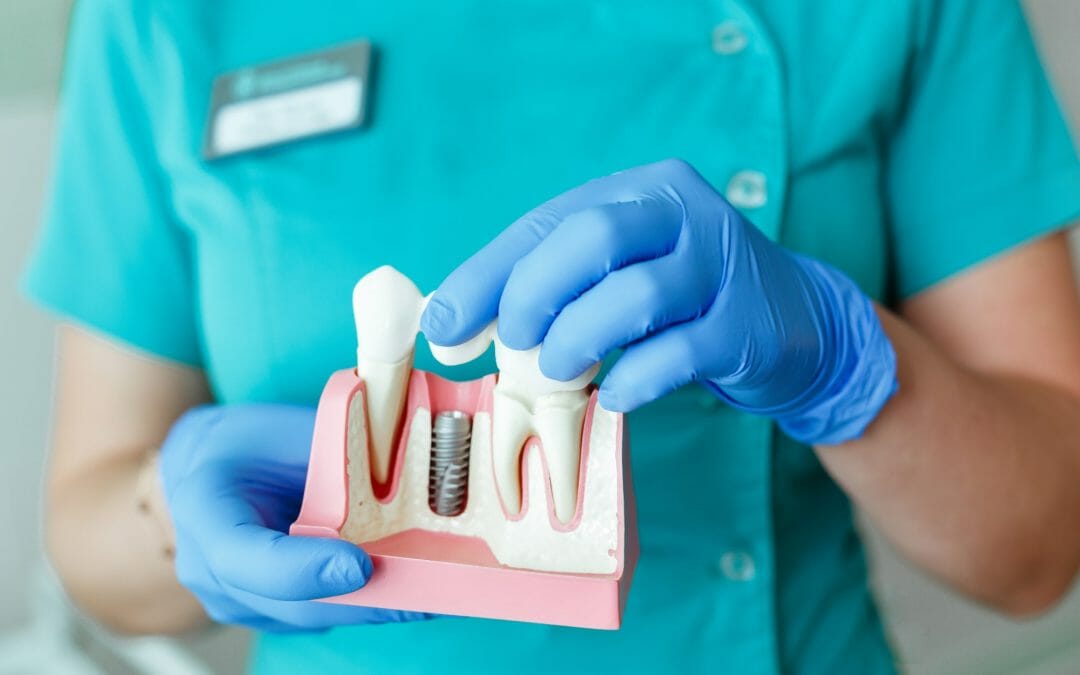Dental implants are one of the most popular options for replacing missing teeth. Implants can help patients who are missing one or multiple teeth to restore their smiles to their complete form and function. While there are many treatment options available for restoring smiles, dental implants are generally considered to be the best in terms of how closely they resemble and work like natural teeth.
Choosing to get dental implants, however, is not a small decision. We recommend that patients talk with us about the costs, contraindications, and the process before they decide which smile restoration treatment is right for them.
What to Expect When Getting a Dental Implant
Initial Consultation
The dental implant process begins with an initial consultation with our dentist. During this consultation, Dr. Harding collects the patient’s medical history and talks with the patient about their goals for their smile restoration, examines their teeth, and might also take x-ray images to evaluate the patient’s existing jawbone structure.
If it is determined that the patient is a candidate for dental implants, we then recommend the patient to a local oral surgeon to begin the process. We also forward any relevant patient information to their office.
Oral Surgeon Referral and Evaluation
Once the patient has been referred to an oral surgeon and has scheduled an appointment, they then meet with the oral surgeon to review and discuss their patient file and treatment goals, in addition to collecting any additional diagnostic images that might be necessary, such as a CBCT scan.
At this time, your oral surgeon can talk with you about your existing jawbone structure and help you determine whether or not a bone grafting procedure is going to be necessary to prepare your jawbone for dental implant placement. Since the jawbone naturally deteriorates in the absence of stimulation by tooth roots, some patients might not have adequate bone mass present to support a dental implant anchor. When this is the case, the next step in the implant process is a bone grafting procedure.
Bone Grafting and Recovery Time
A bone grafting procedure takes place in the oral surgeon’s office and can typically be completed using only local anesthetics to thoroughly numb the treatment area. If a patient has dental anxiety or a dental phobia, we recommend speaking with the oral surgeon about sedation dentistry options to minimize stress during the procedure and the rest of the dental implant process.
During a bone grafting procedure, an oral surgeon makes an incision in the patient’s gum tissue to access the jawbone and then places a small amount of bone at the treatment location. The gum tissue is then sewn up with sutures and the jawbone is left to heal. The bone graft then fuses with the patient’s jawbone and stimulates the production of additional bone matter. Once thoroughly healed and augmented, the patient is ready to receive their implant anchor.
Implant Anchor Placement Procedure and Recovery Time
An implant anchor is a small, biocompatible, screw-like dental device that is placed in the jawbone to act as a tooth’s natural roots. Like a bone grafting procedure, the implant anchor placement procedure occurs in the oral surgeon’s office with the treatment area numbed using local anesthetics.
Following the placement of the implant anchor, another recovery period then occurs. During this time, the patient’s jawbone and the implant anchor undergo a process called osseointegration where the bone fuses to the anchor, holding it securely in place. This recovery period typically requires anywhere from three to six months. During this time, the oral surgeon will ensure you are scheduled for follow-up examinations to closely monitor the healing process.
Abutment Placement and Recovery Time
Once the implant anchor is fully integrated with the jawbone, the oral surgeon can then place the implant’s abutment. This is another metal dental appliance that is designed to connect the top of the implant anchor to the patient’s tooth replacement (dental crown). Depending on how the patient’s tissues healed around the implant anchor, this process might also require anesthetics and a short recovery period.
Final Dental Crown Placement
Once the abutment has been placed and all of the patient’s gum tissues have healed, our dentist can then take a 3D scan of the patient’s gum tissues, implant’s abutment, and neighboring teeth to design a dental crown for the patient. We then manufacture the crown and permanently cement it to the implant’s abutment.
Ongoing Care
We then keep an eye on the patient’s dental implant at each subsequent dental examination. To ensure your implant stays healthy and in good shape, continue practicing excellent oral hygiene to prevent periodontal disease from developing, wear a mouthguard during potentially dangerous physical activities, and avoid using your dental crown to chew on hard objects or ice.
The Benefits of Dental Implants
Although getting a dental implant might seem daunting, dental implants offer several benefits and advantages over other tooth replacement treatment options.
- Dental implants look and feel just like natural teeth.
- Dental implants work just like natural teeth.
- They are permanent, which means they do not shift or move around in the mouth the way other dental restorations can.
- Dental implants provide stimulation and pressure to the jawbone which helps preserve its natural form, whereas other tooth replacement options can result in the deterioration of the jawbone over time.
- They are easy to care for as they are brushed and flossed just like natural teeth.
Restorative and Cosmetic Dentistry in West Bend
If you are missing one or more teeth, and think that dental implants might be the right smile restoration option for you, we encourage you to schedule a consultation with Dr. Harding. He can evaluate your teeth and jawbone and provide you with a referral to a local, highly reputable oral surgeon to begin the process. Once your implant anchor has been placed, we can work with you in our office to complete your dental implant with a custom-designed and manufactured dental crown.
To learn more or schedule an appointment with Dr. Harding at Dentistry of West Bend, we welcome you to contact our office today.


Recent Comments